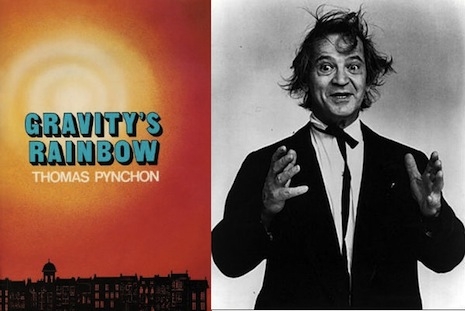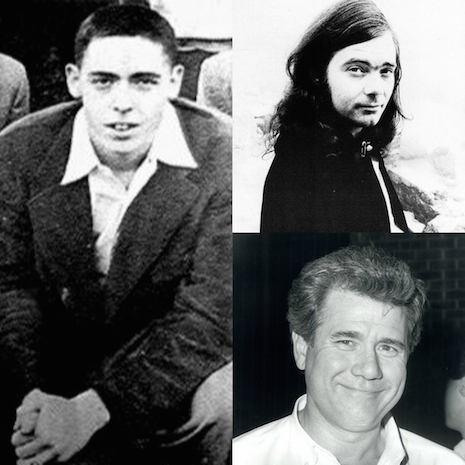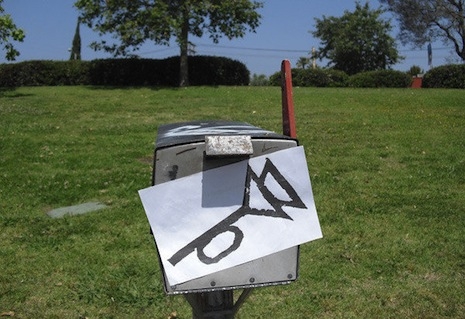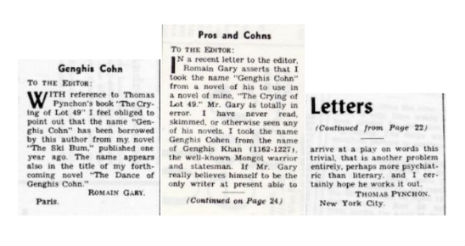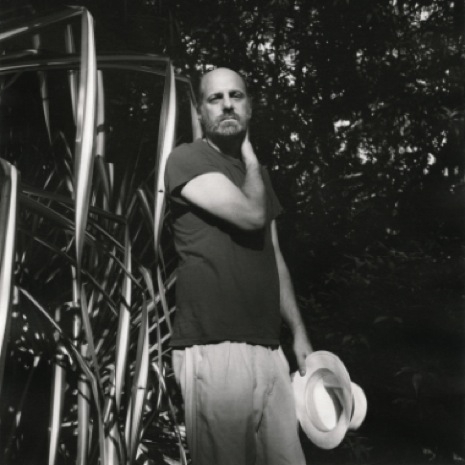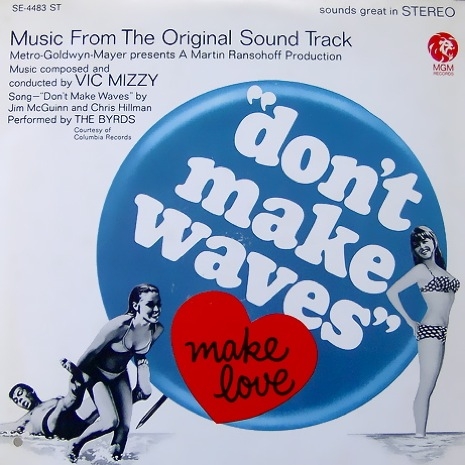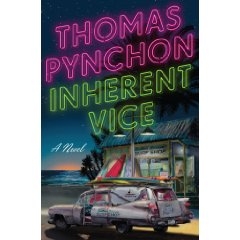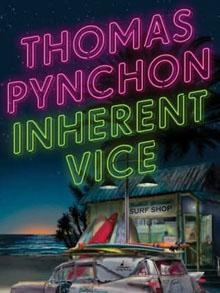
Novelist Thomas Pynchon has a slightly overstated reputation as a literary recluse. After three ambitious novels between 1963 and 1973—the last of which, Gravity’s Rainbow, has a pretty strong claim as the best and most important U.S. novel written after 1970—Pynchon took a break from publishing new work that lasted 17 years. There are only a handful of existing photographs of Pynchon, and they’re all grainy black-and-white shots from early in his life. Despite living on the Upper West Side of Manhattan for many years, not many people know what he looks like.
But he’s no J.D. Salinger. Since 1997 he’s published four novels; measured by number of pages, his post-1997 output must far outstrip the three novels and handful of short stories that established his reputation. He pops up here and there, lending liner notes to Nobody’s Cool, an album by the indie rock band Lotion, or Spiked!, a collection of tunes by Spike Jones, whom Pynchon has cited as a key influence on his work.
Pynchon’s cult of personality is strong enough that the question of his extra-fictional writings is no casual matter. So when a brief piece by Pynchon pops up in, of all places, the Japanese edition of Playboy a few months after 9/11 urging readers to regard Osama bin Laden as a “symbol,” that’s the kind of thing that sets the Pynchon obsessives to speculating. There’s not any obvious reason to believe that the article was faked, save Pynchon’s track record of pranks and the unlikely venue. It’s just barely mysterious enough that you might see it referred to as Pynchon’s “interview about bin Laden”—complete with skeptical quotation marks. Its very existence is a bit of a puzzle.
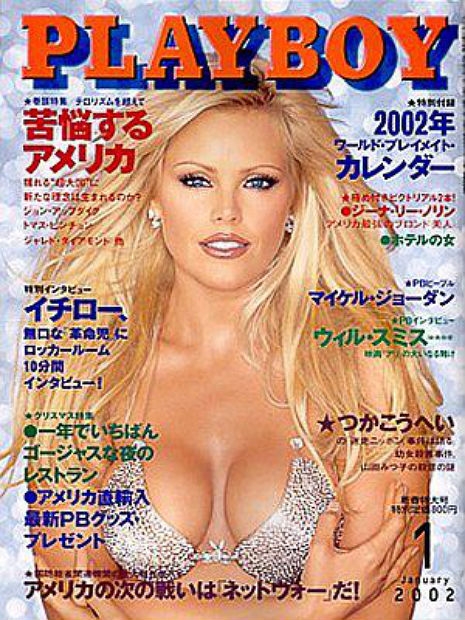
The item exists, for English readers, in translation only, one executed by the diligent “Naoki” of the Pynchon-L newsgroup. It’s important that the piece is billed as an “interview,” because only that would explain the relatively pedestrian quality of the words. (Try to imagine James Joyce translated into Japanese and back into English again. The original text and the outcome might not be all that similar.) The text does seem tolerably Pynchonian. He remarks that he’s afraid to use the subway; there’s more about anthrax than you would find in a remembrance of 9/11 written today; he says that he can’t trust the New York Times anymore; he discusses the anomic qualities of the CNN newscasters.
Most interesting is his plea to stop taking Osama bin Laden so seriously. It’s one of those insights that’s obviously correct but also functionally useless: we were always going to take Osama bin Laden very seriously. As he says, “Even if the United States succeeds in killing him that would mean that there are still 19 bin Ladens left. Even if there is only one, there are probably many people who would take his place once they kill bin Laden. ... If we look at this from a different point-of-view, we should look at bin Laden as a symbol rather than a man. Bin Laden may not even exist.”
Here’s Naoki’s translation of the “interview,” with a few typos corrected:
Most News Is Propaganda. Bin Laden May Not Exist.
All people who live in New York today have been talking about recently is whether they have been to the site of the World Trade Center. This is because it has become a “trendy” topic. Personally, I still cannot find myself wanting to go see the site.
The main thing that has changed in my life-style recently is the fact that I do not ride the subway anymore. Before, I got on the subway wherever I went but today, I never ride the subway in fear of biological weapons. After all, there was the case with the Tokyo Sarin Gas. I believe that the damage that can be caused by the biological weapon called anthrax is increasing and we are in a situation where someone could use biological weapons at any time.
The media station that is consistently giving reports on this terrorist case is CNN. Because everybody watches CNN, it would be safe to say that the news being watched by all of the citizens is the same. However, it is dangerous when people start to believe that what they see is real news.
For the television stations this kind of situation should be a great chance to express their individuality. However, the only thing the newscasters do is read the news in a monotonous voice or when the news comes on during the report, all they do is spit out the words they receive. In any case, they talk with the mere intention of filling up the time they have on air.
The adjective “affect less” best fits the way the newscasters talk. It is a way of expression that has no connection to the human being and no emotional power at all. I deprecate this way of expression. If you listen closely to those words, it doesn’t sound like real news. It sounds more like propaganda.
Talking of propaganda, what changed the most due to the terrorist incident is The New York Times. Until recently, I would wake up an hour early to go buy this newspaper but now, there it isn’t even worth the time to sit down and read it. Even before I place my hips in the seat, I am already finished reading it by flipping through the pages. It wouldn’t be wrong to say that there is hardly any useful news. It is mostly propaganda.
The news on how there are more antibiotics to anthrax other than cipro was a little useful, but that kind of useful news has become a rarity. The New York Times is usually known to be the most reliable source of media when doing research on something that happened twenty to thirty years ago. However, that is no longer the case. The most reliable newspaper that is read by educated people today is probably England’s The Guardian. Everyone is reading it on the internet. I also believe that a lot of the information coming out of the White House is also propaganda.
The problem is that common people cannot make a distinction between news and propaganda. On the contrary, the news sent out from Israel is extremely reliable.
In any case, once a war happens, the war for media becomes a great significance and even the newspapers that look decent at first glance, you can no longer trust. About a hundred years ago, the man who started publishing the Daily Mile said the following: “News is something somebody wants to suppress. Everything else is propaganda.”
Therefore, all information that can be obtained without difficult coverage, even though it may be from the White House, you can think of as propaganda.
Bin Laden should be looked upon as a symbol
The United States has always had a tendency to look for an enemy. It is a country that cannot stand not having one. Even for this terrorist incident, it is already determined that the villain behind all of this is bin Laden, but in reality they are saying that because they cannot stand not doing so. I believe that bin Laden is someone’s clown for a rodeo.
Although my thoughts are always paranoid, I believe that I’m the only one who feels this way. It is said that NSA is on a lookout for him but I think that like an onion, new layers will be discovered. No matter how I look at the situation, it doesn’t seem like bin Laden is doing this independently. The only impression that I get is that he is some kind of star actor.
Honestly speaking, we cannot even tell if the face that comes out on television and on the newspapers is his real face. I remember someone saying right after the terrorist incident, “Come on, you want bin Laden? We’ll give you 20 of him.” Even if the United States succeeds in killing him that would mean that there are still 19 bin Ladens left. Even if there is only one, there are probably many people who would take his place once they kill bin Laden.
If we look at this from a different point-of-view, we should look at bin Laden as a symbol rather than a man. Bin Laden may not even exist.
The other day when I was surfing the net, it said that the punishment that suits bin Laden the best is to catch him alive, bring him to a hospital, give him a transexual operation, and send him back to Afghanistan. He would then understand the disservice done to the women in Afghanistan.
We cannot forget that many of bin Laden’s brothers were partners with George Bush Jr. for the purpose of oil ventures in the past. The doctor who is known to be at bin Laden’s side at all times was a member of the group who killed Sadat. When that assassination happened, Egypt became involved and there must have been people who fled to Afghanistan.
What is often said is that it is the United State’s wealth that is the cause of the terrorists’ hatred. I can understand their feelings well. When I see a wealthy person, I instinctively feel anger deep in my stomach. If you think about how Afghanistan is one of the poorest countries in the world, it is only natural for them to feel hatred toward the wealthy United States. They have no other choice but to detest them.
Even if the United States stops their support for Israel, I don’t think that everything will become peaceful. However, from their point-of-view this is the origin of all Israel’s mistakes.
On a final note, if I were to vigorously invest in something right now, I would invest in the tobacco industry. After that incident, people who had stopped smoking before have started it again.
On the Pynchon Wiki, two presumably well-informed commenters offer their opinion that the bin Laden piece is authentic. The reasoning of commenter “Bleakhaus” is fairly persuasive.
I for one am inclined to believe its authenticity. It expresses many of Pynchon’s longest- and deepest-held thoughts:
Paranoia - afraid to ride subway.
Extended thoughts on his distrust of news media - mentions CNN in particular (same station that tracked him down at one point).
He suggests that he used to like the New York Times - in fact, he wrote numerous articles for the Times.
Bin Laden as a symbol - 9/11 is treated symbolically in Against the Day.
sense of humor - consistent with Pynchon’s sense of humor in Against the Day.
The Playboy Japan article also quoted John Updike, Thomas Friedman and others. It would be odd that a bogus Pynchon interview would end up mixed in with those legitimate interviews.
Hating the rich - a very strong theme in Against the Day.
Finally, like Pynchon’s Simpsons appearance, the whole thing is just too unusual to be invented. Playboy Japan, of all things?
Obviously, 9/11 is an ideal subject for a writer who plumbed the subject of paranoia so thoroughly in The Crying of Lot 49 and Gravity’s Rainbow. What “Bleakhaus” couldn’t have known when he or she wrote this is that, while Against the Day (2006) may touch on 9/11 symbolically, his 2013 book Bleeding Edge deals with it literally—it’s part of the book’s plot.
